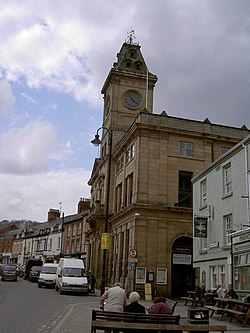Difference between revisions of "Welshpool"
(Created page with '{{Infobox town |name=Welshpool |welsh=Y Trallwng |county=Montgomeryshire |picture=Welshpool Town Hall.jpg |picture caption=Welshpool Town Hall |os grid ref=SJ225075 |latitude=52.…') |
(→History) |
||
| (2 intermediate revisions by the same user not shown) | |||
| Line 18: | Line 18: | ||
'''Welshpool''' is a town in [[Montgomeryshire]]. The town is low-lying on the [[River Severn]]; the Welsh language name ''Y Trallwng'' literally meaning 'the marshy (or sinking) land'. | '''Welshpool''' is a town in [[Montgomeryshire]]. The town is low-lying on the [[River Severn]]; the Welsh language name ''Y Trallwng'' literally meaning 'the marshy (or sinking) land'. | ||
| − | + | The town was initially known as '''Pool''' or '''Poole''' but its name was changed to Welshpool in 1835 to distinguish it from [[Poole]] in [[Dorset]].<ref>{{cite book |editor1-first=John |editor1-last=Davies|editor1-link=John Davies (historian)|editor2-first=Nigel |editor2-last=Jenkins | editor2-link=Nigel Jenkins| editor3-first=Baines |editor3-last=Menna|editor4-first=Peredur I. |editor4-last=Lynch|title=The Welsh Academy Encyclopaedia of Wales |year=2008 |publisher=University of Wales Press |location=Cardiff|page=944 |isbn=978-0-7083-1953-6}}</ref> It had a population of 6,269 as at the 2001 Census and contains much Georgian architecture. A little to the south lies Powis Castle, seat of the Earl of Powis. | |
==History== | ==History== | ||
Welshpool served briefly as the capital of the principality of Powys Wenwynwyn, or South Powys, after its prince was forced to flee the traditional Welsh Royal site at Mathrafal in 1212. After 1284 Powys Wenwynwyn ceased to exist. The Long Mountain plays as a backdrop to most of Welshpool, which once served as the ultimate grounds for defence for fortresses in the times when the town was just a swampy marsh. | Welshpool served briefly as the capital of the principality of Powys Wenwynwyn, or South Powys, after its prince was forced to flee the traditional Welsh Royal site at Mathrafal in 1212. After 1284 Powys Wenwynwyn ceased to exist. The Long Mountain plays as a backdrop to most of Welshpool, which once served as the ultimate grounds for defence for fortresses in the times when the town was just a swampy marsh. | ||
| − | The town was devastated by the forces of Owain Glyndŵr in 1400 at the start of his rebellion against | + | The town was devastated by the forces of Owain Glyndŵr in 1400 at the start of his rebellion against King Henry IV. Today the waymarked [[Long-distance footpaths in the United Kingdom|long-distance footpath]] and National Trail [[Glyndwr's Way]] runs through the town. |
St Cynfelin (he is also known as St Matu) is reputed to be the founder of the church in "the age of the saints in Wales" in the 5th and 6th centuries. | St Cynfelin (he is also known as St Matu) is reputed to be the founder of the church in "the age of the saints in Wales" in the 5th and 6th centuries. | ||
Latest revision as of 13:34, 3 November 2014
| Welshpool Welsh: Y Trallwng | |
| Montgomeryshire | |
|---|---|
 Welshpool Town Hall | |
| Location | |
| Grid reference: | SJ225075 |
| Location: | 52°39’35"N, 3°8’50"W |
| Data | |
| Population: | 6,269 (2001) |
| Post town: | Welshpool |
| Postcode: | SY21 |
| Dialling code: | 01938 |
| Local Government | |
| Council: | Powys |
| Parliamentary constituency: |
Montgomeryshire |
Welshpool is a town in Montgomeryshire. The town is low-lying on the River Severn; the Welsh language name Y Trallwng literally meaning 'the marshy (or sinking) land'.
The town was initially known as Pool or Poole but its name was changed to Welshpool in 1835 to distinguish it from Poole in Dorset.[1] It had a population of 6,269 as at the 2001 Census and contains much Georgian architecture. A little to the south lies Powis Castle, seat of the Earl of Powis.
Contents
History
Welshpool served briefly as the capital of the principality of Powys Wenwynwyn, or South Powys, after its prince was forced to flee the traditional Welsh Royal site at Mathrafal in 1212. After 1284 Powys Wenwynwyn ceased to exist. The Long Mountain plays as a backdrop to most of Welshpool, which once served as the ultimate grounds for defence for fortresses in the times when the town was just a swampy marsh.
The town was devastated by the forces of Owain Glyndŵr in 1400 at the start of his rebellion against King Henry IV. Today the waymarked long-distance footpath and National Trail Glyndwr's Way runs through the town.
St Cynfelin (he is also known as St Matu) is reputed to be the founder of the church in "the age of the saints in Wales" in the 5th and 6th centuries.
There is a six-sided, brick cock-pit which was built in the early 18th century and was in continual use for cockfighting until the practice was outlawed in 1849. This is the only unaltered cockpit preserved on its original site in Britain.
Economy
The local economy is primarily based upon agriculture and local industry. The Smithfield Livestock Market is the largest one-day sheep market in Europe, whilst the town's industrial estates are home to numerous different types of small industry.
Due to the town's small size and population the attraction of high street stores is limited, meaning many of the residents are forced to shop in neighbouring towns like Newtown and Shrewsbury.
Notes
- ↑ Davies, John; Jenkins, Nigel; Menna, Baines et al., eds (2008). The Welsh Academy Encyclopaedia of Wales. Cardiff: University of Wales Press. p. 944. ISBN 978-0-7083-1953-6.
Outside links
- Welshpooltownfc.co.uk - Welshpool Town Football Club
- Welshpool Hockey Club- Website of Welshpool Hockey Club, who compete in the North Wales League
- Welshpool Rugby Club- Website of Welshpool Rugby Union Football Club, who compete in the Welsh National League
- photos of Welshpool and surrounding area on geograph